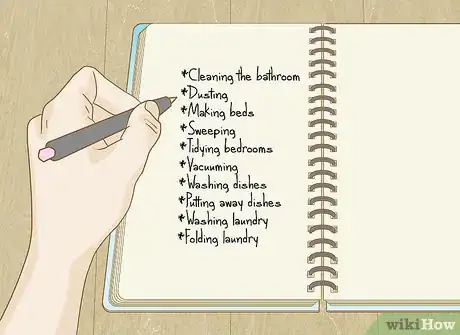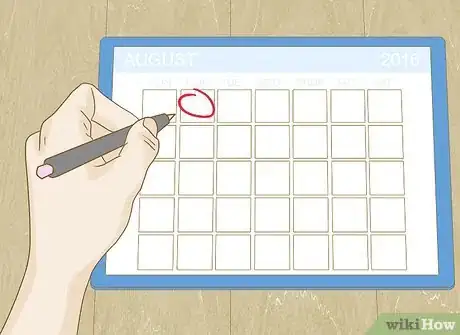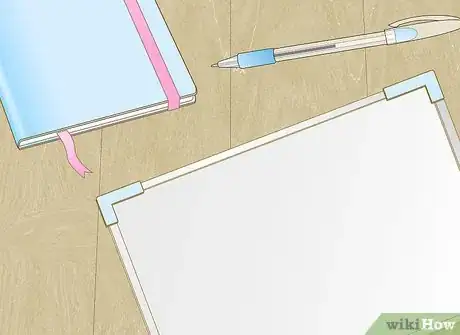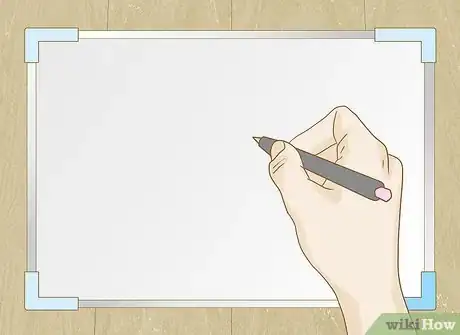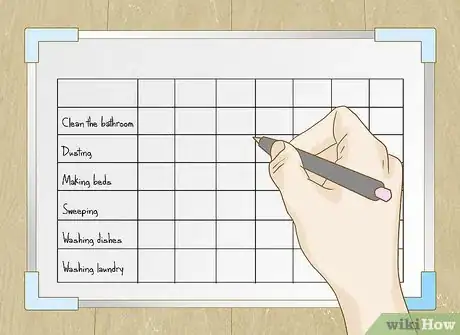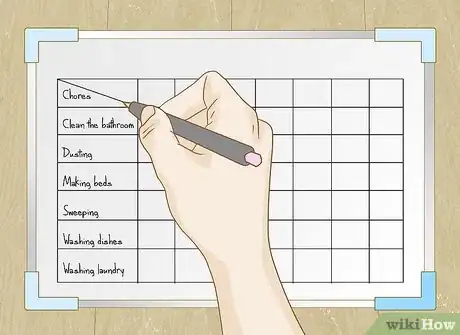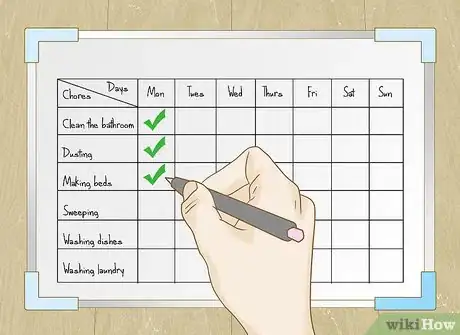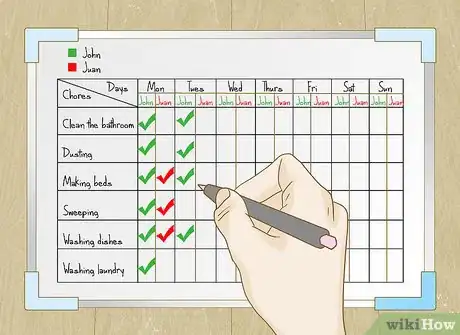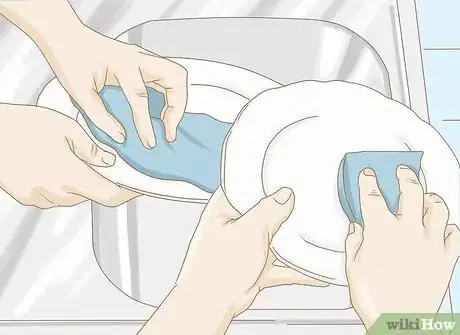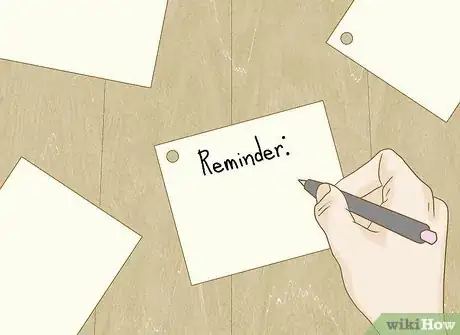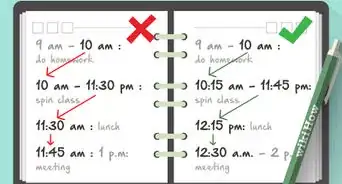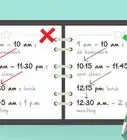This article was co-authored by Wits End Parenting. Wits End Parenting is a parent-coaching practice based in Berkeley, California specializing in strong-willed, “spirited” children with impulsivity, emotional volatility, difficulty “listening,” defiance, and aggression. Wits End Parenting's counselors incorporate positive discipline that is tailored to each child’s temperament while also providing long-term results, freeing parents from the need to continually re-invent their discipline strategies.
There are 7 references cited in this article, which can be found at the bottom of the page.
This article has been viewed 69,919 times.
A chore chart is an excellent way to keep track of your daily responsibilities and maintain a well-kept home. An orderly home will make your guests feel more comfortable, your possessions last longer, and the overall atmosphere of your home more pleasant appearing and smelling. Add the fact that it's always easier to lay your hands on something put away in the right place, and it's hard to imagine why someone wouldn't make use of a chore chart. With a few supplies and an awareness of what needs to be done, you'll soon be checking off chores on your very own chore chart.
Steps
Planning Your Chore Chart
-
1Write a list of all your chores. Take your pen and paper and take some time to think about all the chores that will need to be done to keep your home clean and orderly. Depending on your home, these chores may vary. For example, if you have pets of livestock, you'll need to include these in your chore list! Some common chores include:[1]
- Cleaning the bathroom
- Dusting
- Making beds
- Sweeping
- Tidying bedrooms
- Vacuuming
- Washing dishes
- Putting away dishes
- Washing laundry
- Folding laundry
-
2Choose the best schedule for your daily life. Take note of the schedules of those who will be doing the chore list. For example, if you're making a chore chart for your roommate who is generally busy in the morning but free in the evening, you chart his chore-work for evening hours.
- Chore charts can be as general or specific as you like. For those who have difficulty finding time to do chores, you may want a very specific chore chart and schedule.
- Some people find it easier to assign chores to a day, or even week. In this case, the person who has to do the chore will have an entire day or week to check off the chore from the chart.[2]
Advertisement -
3Divide and conquer. Not only will splitting up the chores you have make less work for everyone, it will also give a sense of solidarity to all involved. Even if you're a parent who doesn't need a chore chart, listing your many chores next to the responsibilities of your kids might gain you more appreciation for all the work you do.
- This is a great technique for children who are resistant to chores. Once they see how much work you do next to their few around-the-house tasks, they'll likely be less difficult.
- Allow some flexibility with chore assignments. If someone particularly hates a specific chore, maybe a less hated one can be exchanged for it.[3]
-
4Gather your chore chart making materials. There are many different ways you can make a chore chart. You could even turn your chore chart into a personalized craft for your kids. Simply allow them to draw out their own chart on several pages in a notebook and decorate it with drawings, favorite characters, and stickers.[4] Some other supplies you might find helpful include:[5]
- Binder ring (optional)
- Card stock (optional)
- Dry erase board
- Dry erase markers
- Hole punch
- Notebook (optional)
- Paper (optional)
- Pen (optional)
- Stickers (optional)
Making a Chore Chart
-
1Prepare your supplies. Depending on the style of chore chart you're making, these may vary, but having all your supplies on hand will help speed you through your chore chart creation. For the purposes of offering a guided example, the following chore chart uses a dry erase board and markers.
-
2Create a calendar with eight columns. The first column will be where you write down chore names, so you'll need it to be wider than the rest. The seven columns to the right will be where the chore-doer marks whether the chore has been finished or not. These seven columns can be much smaller than your first.
- If you have five chores, you should have at least six rows. The topmost row will be for days of the week, so you'll need one more row than your number of chores.[6]
-
3Draw a diagonal line in the upper left hand box. Do so from the upper left of the box to its lower right corner. In the bottom left triangle, write "Chores" to indicate the left column is for chores. In the upper right triangle, write "Days" to indicate the top row is for days. This way there won't be any confusion, and your chart will look tidy and complete.
-
4List responsibilities and write out the days of the week. Skipping the upper left hand box, write out the chores in the leftmost column of your chart. You might also want to include special information here. For example, for bi-weekly chores you might put "Bi-weekly" in parentheses below the listed chore. In the topmost row, skipping again the upper leftmost box, write the days of the week.
- If you don't have enough room in your top row to write out the entire name of each day of the week, use simple abbreviations, like: M, T, W, TH, F, S, SU
-
5Mark off completed chores. This can be as simple as marking a chore complete with a check mark in the appropriate column when it's done. However, if you want to do the marking yourself to keep the chore doer honest, you can use the same procedure when you are informed the chore is complete.
- For example, when the chore doer's bed is made, you'll put a check mark in the box to the right of "Make Bed" in the corresponding column for the day of the week.
- For children especially resistant to chores, you may want to do a brief inspecting of the work before you hand out a check mark.
-
6Offer chore incentives to make joyful workers.[7] Even a small prize can be great motivation for a young child, but incentives work well for adults, too. If you have a roommate who's particularly messy, you can offer to buy him a pizza if he manages to stay on top of his chores for the month. Kids can be given small rewards, like stickers or small toys.[8]
-
7Use different colored markers for multiple people. Take your marker and write a color code at the top of the chart. For example, orange might be for Billy and green for Susan. Then, when each child completes a chore, you can write a check mark in the appropriate color.
- For chores that alternate doers per day, week, or a similar situation, you might want to use initials to mark the chore complete and keep track of order.
- For example, if Billy takes out the trash Tuesday but Susan is expected to on Thursday, initials would clearly indicate both whose turn it is and chore completion.
-
8Separate chore lists for picky chore doers. Some kids, and even some adults, don't like their things to get mixed with others. This may be due to the greater clarity of having one's own chart, but regardless, you can satisfy picky chore doers by giving each person their own chart.[9]
-
9Make a daily and weekly chart with names in the columns. By making a daily chart, the chore doers will know that sometime during the day, all chores on the list will be done. This way, it doesn't matter which day of the week it is, all that matters is whether or not the chore was finished. Simply replace the days of the week with the names of the chore doers. When a chore is complete, it should be marked on the chart.
Ensuring the Job gets Done
-
1Supervise and lend a helping hand. If you are trying to teach your kids responsibility, you might not want to do their chores for them. However, by lending a helping hand or offering encouragement and advice, you can turn chores into a bonding experience.
- Play the word chain game while you work. Choose a category, and take turns while doing chores chaining together the last letter of a word in that category with the first letter of the next word. For example:
Category: Sports
baseball → luge → eight ball → limbo ...
- Play the word chain game while you work. Choose a category, and take turns while doing chores chaining together the last letter of a word in that category with the first letter of the next word. For example:
-
2Offer reward for full completion. Rewards will be unique to each situation. Younger children can be persuaded to work diligently with small prizes, like stickers or dollar store toys. Older chore doers might enjoy a free pizza or a night at the movies. Whatever the case, a little motivation goes a long way.[10]
-
3Award points for chores completed. You can award more or less points depending on the difficulty of the task, but be sure you are consistent with your scoring. Unfairness can lead to stubborn chore doers becoming more resistant to your efforts due to a perceived lack of fairness.
-
4Create chore reminder cards. You might notice that the chore doers consistently forget to clean something completely, or that certain aspects of the chore are avoided. In this case, you can improve accountability and squash excuses by writing out chore "recipe" cards. Simply:
- Write down all parts involved in doing the chore on card stock and punch a hole in its upper left hand corner.
- Put a binder ring in the punched corner.
- Leave the card in the room where the chore will be done.
- Attach the binder ring somewhere obvious, but out of the way. Maybe on the arm of a lamp, or onto a rung of a chair that sits off in the corner.
- For rooms that have multiple chores, you can collect several cards on the same binder ring.
Things You'll Need
- Binder ring (optional)
- Card stock (optional)
- Dry erase board
- Dry erase markers
- Hole punch
- Notebook (optional)
- Paper (optional)
- Pen (optional)
- Stickers (optional)
References
- ↑ http://www.rent.com/blog/how-to-make-a-chore-chart/
- ↑ http://www.rent.com/blog/how-to-make-a-chore-chart/
- ↑ https://www.sparefoot.com/self-storage/blog/5689-tips-for-splitting-up-household-chores/
- ↑ http://www.tipjunkie.com/post/chore-chart-reward-systems/
- ↑ http://www.livingwellspendingless.com/2014/09/19/great-chores-kids/
- ↑ http://crystalandcomp.com/activites-for-kids-how-to-make-a-chore-chart/
- ↑ Wits End Parenting. Parenting Specialists. Expert Interview. 5 March 2020.
- ↑ http://crystalandcomp.com/activites-for-kids-how-to-make-a-chore-chart/
- ↑ http://aspottedpony.com/diy/make-cleaning-fun-for-kids-with-a-simple-diy-chore-chart/3867/
About This Article
To make a chore chart, start by writing out a list of chores that need to be done in your household on a weekly basis. Next, divide the tasks among the members of your household, taking account of each person’s abilities and schedules. Then, draw a chart on a dry erase board with eight columns and as many rows as you have chores. In the first column, list each chore, and on the top row, list each day of the week. Finally, have each person put a check mark in the correct spot with a marker in their assigned color each time they finish a chore. For tips on how to motivate your kids to do their chores, keep reading!
